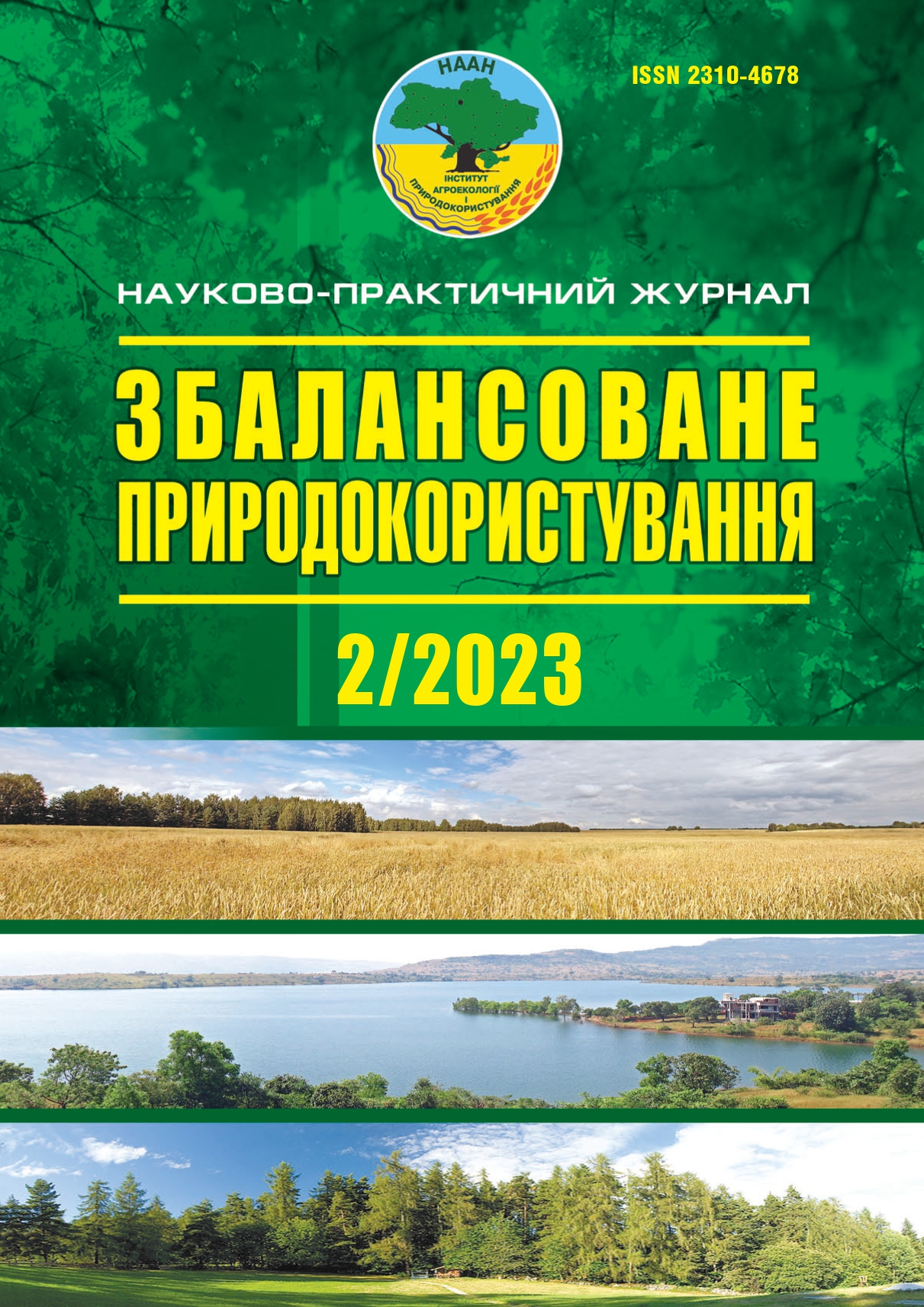Вплив гербіцидів на чисельність і розвиток Lumbricus terrestris
DOI:
https://doi.org/10.33730/2310-4678.2.2023.282756Ключові слова:
засоби захисту рослин, ґрунтові гербіциди, дощові черв’яки, глютатіон-S-трансфераза, ацетилхолінестераза, соняшник, хлораценіліди, триазиниАнотація
Необмежене використання гербіцидів для боротьби з бур’янами в сільському господарстві призводить до зменшення окремих чутливих популяцій ґрунтової біоти, серед яких варто звернути увагу на Lumbricus terrestris. Оскільки саме вони складають доволі значну частину живої біомаси ґрунту та відіграють важливу роль у функціонуванні ґрунту. Застосування ґрунтових гербіцидів суцільної дії може викликати не лише 100% летальність, але й впливати на функціонування, ріст, розмноження та габітус особин Lumbricus terrestris. У статті наведено результати польових дослідів і лабораторних досліджень впливу ґрунтових гербіцидів різних хімічних класів на чисельність і розвиток Lumbricus terrestris. Результатами досліджень встановлено негативну дію на розвиток і чисельність особин дощового черв’яка (Lumbricus terrestris) у ґрунті агроценозу соняшнику за застосування гербіцидів. Кількість особин дощового черв’яка зменшувалась у 2,1 раза за внесення триазинових гербіцидів (Гезагард) і в 3,7 раза за внесення хлорацетомідів (Дуал Голд, Харнес) на 30-ту добу порівняно до контролю. Крім того, лабораторіні дослідження довели, що застосування ґрунтових гербіцидів у рекомендованих нормах внесення активізує синтез глутатіон-S-трансферази в дощового черв’яка, і його вміст збільшується на 5,6–8,9% вже через добу контакту з Харнесом та Дуал Голд (1 min D), тоді як при контакті із гербіцидом Гезагард зростання було на 4,1% лише на 7-у добу експерименту. Пригнічення синтезу ацетилхолінестерази дощового черв’яка при контакті з Харнес та Дуал Голд відбулося в середньому на 43,0% вже через 24 год і з Гезагард — на 23,4%.
Посилання
Calisi, A., Grimaldi, A., Leomanni, A., Lionetto, M.G., Dondero, F., Schettino, T. (2016). Multibiomarker response in the earthworm Eisenia fetida as tool for assessing multiwalled carbon nanotube ecotoxicity. Ecotoxicology, 25, 677–687. DOI: https://doi.org/10.1007/s10646-016-1626-x [in English].
Calisi, A., Lionetto, M., Lemanni, A., De Lorenzis, E., Schettino, T. (2014). Metallothionein induction in the coelomic fluid of the earthworm Lumbricus terrestris following heavy metal exposure: a short report. Biomed Research International, 2014, 1–6. DOI: https://doi.org/10.1155/2014/109386 [in English].
Calisi, A., Zaccarelli, N., Lionetto, M., Schettino, T. (2013). Integrated biomarker analysis in the earthworm Lumbricus terrestris: application to the monitoring of soil heavy metal pollution. Chemosphere, 90, 2637–2644. DOI: https://doi.org/10.1016/j.chemosphere.2012.11.040 [in English].
Chen, C., Wang, Y., Zhao, X., Wang, Q., Qian, Y. (2014). Comparative and combined acute toxicity of butachlor, imidacloprid and chlorpyrifos on earthworm Eisenia fetida. Chemosphere, 100, 111–115. DOI: https://doi.org/10.1016/j.chemosphere.2013.12.023 [in English].
Garcia-Torres, T., Guiffré, L., Romaniuk, R., Ríos, R.P., Pagano, E.A. (2014). Exposure assessment to glyphosate of two species of annelids. Bull. Environ. Contam. Toxicol, 93, 209–214. DOI: https://doi.org/10.1007/s00128-014-1312-8 [in English].
Kalogiannidis, S., Kalfas, D., Chatzitheodoridis, F., Papaevangelou, O. (2022). Role of Crop-Protection Technologies in Sustainable Agricultural Productivity and Management. Land, 11 (10), 1–21. DOI: https://doi.org/10.3390/land11101680 [in English].
Kautenburger, R. (2006). Impact of different agricultural practices on the genetic structure of Lumbricus terrestris, Arion lusitanicus and Microtus arvalis. Animal Biodiversity and Conservation, 29 (1), 19–32. DOI: https://www.researchgate.net/publication/26440952 [in English].
Leomanni, A., Schettino, T., Calisi, A., Lionetto, M. (2016). Mercury induced haemocyte alterations in the terrestrial snail Cantareus apertus as novel biomarker. Comparative Biochemistry and Physiology, 183–184, 20–27. DOI: https://doi.org/10.1016/j.cbpc.2016.01.004 [in English].
Lionetto, M., Caricato, R., Giordano, M., Schettino, T. (2016). The complex relationship between carbonic anhydrase and trace metals: new insight and perspectives. International Journal of Molecular Sciences, 17, 127–141. DOI: https://doi.org/10.3390/ijms17010127 [in English].
Lionetto, M., Caricato, R., Calisi, A., Giordano, M.E., Erroi, E. (2016). Biomonitoring of water and soil quality: a case study of ecotoxicological methodology application to the assessment of reclaimed agroindustrial wastewaters used for irrigation. Rendiconti lincei, 27, 105–112. DOI: https://link.springer.com/article/10.1007/s12210-015-0486-2 [in English].
Pelosi, C., Joimel, S., Makowski, D. (2013). Searching for a More Sensitive Earthworm Species to be Used in Pesticide Homologation Tests — A Meta-Analysis. Chemosphere, 90, 895–900. DOI: http://doi.org/10.1016/j.chemosphere.2012.09.034 [in English].
Santadino, M., Coviella, C., Momo, F. (2014). Glyphosate sub lethal effects on the population dynamics of the earthworm Eisenia fetida (Savigny, 1826). Water soil Pollut, 225, 2207. DOI: http://doi.org/10.1007/s11270-014-2207-3 [in English].
Tiwari, R.K., Singh, S., Pandey, R.S., Sharma, B. (2016). Enzymes of Earthworm as Indicators of Pesticide Pollution in Soil. Advances in Enzyme Research, 4, 113–124. DOI: http://dx.doi.org/10.4236/aer.2016.44011 [in English].
Yasmin, S., D’Souza, D. (2007). Effect of pesticides on the reproductive output of Eisenia fetida. Bull Environ Contam Toxicol, 79, 529–532. DOI: http://doi.org/10.1007/s00128-007-9269-5 [in English].
Ivantsiv, V.V. (2013). Doshchovi cherviaky (Lumbricidae) grunto-substrativ vidvaliv Boryslavskoho ozokerytovoho rodovyshcha [Earthworms (Lumbricidae) of the soil-substrates of the dumps of the Boryslav ozokerite deposit]. Pryroda Zakhidnoho Polissia ta prylehlykh terytorii: zb. nauk. pr. — Nature of the Western Polissia and adjacent territories: coll. of science works, 10, 113–118 [in Ukrainian].
Mazur, S.O., Matusevych, H.D. (2023). Vplyv gruntovykh herbitsydiv na biometrychni pokaznyka ta vrozhainist soniashnyku [Influence of soil herbicides on biometric indicators and yield of sunflower]. Zbalansovane pryrodokorystuvannia — Balanced nature using, 1, 90–96 [in Ukrainian].
##submission.downloads##
Опубліковано
Номер
Розділ
Ліцензія
- Автори залишають за собою право на авторство своєї роботи та передають журналу право першої публікації цієї роботи на умовах ліцензії Creative Commons Attribution License, котра дозволяє іншим особам вільно розповсюджувати опубліковану роботу з обов'язковим посиланням на авторів оригінальної роботи та першу публікацію роботи у цьому журналі.
- Автори мають право укладати самостійні додаткові угоди щодо неексклюзивного розповсюдження роботи у тому вигляді, в якому вона була опублікована цим журналом (наприклад, розміщувати роботу в електронному сховищі установи або публікувати у складі монографії), за умови збереження посилання на першу публікацію роботи у цьому журналі.
- Політика журналу дозволяє і заохочує розміщення авторами в мережі Інтернет (наприклад, у сховищах установ або на особистих веб-сайтах) рукопису роботи, як до подання цього рукопису до редакції, так і під час його редакційного опрацювання, оскільки це сприяє виникненню продуктивної наукової дискусії та позитивно позначається на оперативності та динаміці цитування опублікованої роботи (див. The Effect of Open Access).


